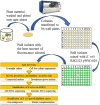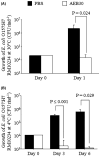Biocontrol of Escherichia coli O157:H7 by Enterobacter asburiae AEB30 on intact cantaloupe melons
- PMID: 38465735
- PMCID: PMC10926056
- DOI: 10.1111/1751-7915.14437
Biocontrol of Escherichia coli O157:H7 by Enterobacter asburiae AEB30 on intact cantaloupe melons
Abstract
Escherichia coli O157:H7 causes >73,000 foodborne illnesses in the United States annually, many of which have been associated with fresh ready-to-eat produce including cantaloupe melons. In this study, we created a produce-associated bacterial (PAB) library containing >7500 isolates and screened them for the ability to inhibit the growth of E. coli O157:H7 using an in vitro fluorescence-based growth assay. One isolate, identified by 16S and whole-genome sequence analysis as Enterobacter asburiae, was able to inhibit the growth of E. coli by ~30-fold in vitro and produced zones of inhibition between 13 and 21 mm against 12 E. coli outbreak strains in an agar spot assay. We demonstrated that E. asburiae AEB30 was able to grow, persist and inhibit the growth of E. coli on cantaloupe melons under simulated pre- and post-harvest conditions. Analysis of the E. asburiae AEB30 genome revealed an operon encoding a contact-dependent growth inhibition (CDI) system that when mutated resulted in the loss of E. coli growth inhibition. These data suggest that E. asburiae AEB30 is a potential biocontrol agent to prevent E. coli contamination of cantaloupe melons in both pre- and post-harvest environments and that its mode of action is via a CDI system.
Published 2024. This article is a U.S. Government work and is in the public domain in the USA. Microbial Biotechnology published by John Wiley & Sons Ltd.
Conflict of interest statement
The authors declare no conflict of interest.
Figures




 cdiB,
cdiB,  cdiA,
cdiA,  cdiI.
cdiI.Similar articles
-
Use of hydrogen peroxide in combination with nisin, sodium lactate and citric acid for reducing transfer of bacterial pathogens from whole melon surfaces to fresh-cut pieces.Int J Food Microbiol. 2005 Oct 15;104(2):225-33. doi: 10.1016/j.ijfoodmicro.2005.01.016. Int J Food Microbiol. 2005. PMID: 16043249
-
Use of Pantoea agglomerans ASB05 as a biocontrol agent to inhibit the growth of Salmonella enterica on intact cantaloupe melons.J Appl Microbiol. 2023 Oct 4;134(10):lxad235. doi: 10.1093/jambio/lxad235. J Appl Microbiol. 2023. PMID: 37852677
-
Bacillus amyloliquefaciens ALB65 Inhibits the Growth of Listeria monocytogenes on Cantaloupe Melons.Appl Environ Microbiol. 2020 Dec 17;87(1):e01926-20. doi: 10.1128/AEM.01926-20. Print 2020 Dec 17. Appl Environ Microbiol. 2020. PMID: 33097500 Free PMC article.
-
Efficacy of Sanitizer Treatments on Survival and Growth Parameters of Escherichia coli O157:H7, Salmonella, and Listeria monocytogenes on Fresh-Cut Pieces of Cantaloupe during Storage.J Food Prot. 2015 Jul;78(7):1288-95. doi: 10.4315/0362-028X.JFP-14-233. J Food Prot. 2015. PMID: 26197279
-
Infections associated with cantaloupe consumption: a public health concern.Epidemiol Infect. 2006 Aug;134(4):675-85. doi: 10.1017/S0950268805005480. Epub 2005 Dec 1. Epidemiol Infect. 2006. PMID: 16318654 Free PMC article. Review.
Cited by
-
Integrating Metagenomic and Culture-Based Techniques to Detect Foodborne Pathogens and Antimicrobial Resistance Genes in Malaysian Produce.Foods. 2025 Jan 22;14(3):352. doi: 10.3390/foods14030352. Foods. 2025. PMID: 39941945 Free PMC article.
-
Harnessing Bacteriophages for Sustainable Crop Protection in the Face of Climate Change.Microb Biotechnol. 2025 Feb;18(2):e70108. doi: 10.1111/1751-7915.70108. Microb Biotechnol. 2025. PMID: 39937142 Free PMC article. Review.
References
-
- Abby, S.S. & Rocha, E.P.C. (2017) Identification of protein secretion systems in bacterial genomes using MacSyFinder. Methods in Molecular Biology, 1615, 1–21. - PubMed
-
- Aoki, S.K. , Pamma, R. , Hernday, A.D. , Bickham, J.E. , Braaten, B.A. & Low, D.A. (2005) Contact‐dependent inhibition of growth in Escherichia coli . Science, 309, 1245–1248. - PubMed
Publication types
MeSH terms
Supplementary concepts
Grants and funding
LinkOut - more resources
Full Text Sources
Research Materials

